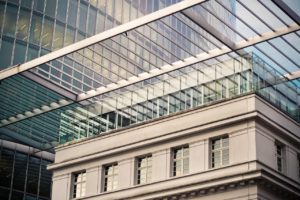The Backbone of Modern Infrastructure

With steel frame structures at the core of modern infrastructure projects, architects and engineers break barriers and reshape skylines. This article will delve into the critical aspects of steel frame solutions and explore their pivotal role in constructing sustainable and resilient buildings.
Unleashing the Potential of Steel Frame Solutions:
Steel frame structures are the backbone of modern construction due to their exceptional strength-to-weight ratio. These solutions create large, open spaces without excessive load-bearing walls or columns. Architects can design buildings that maximise usable space and offer flexibility for future modifications or expansions by utilising steel frame structures.
Durability and Resilience:
One of the most significant advantages of steel frame solutions is their durability. Steel possesses inherent resistance to fire, corrosion, and pests, making it an ideal choice for structures that need to withstand harsh environmental conditions. This durability translates into buildings that have longer lifespans, reducing the need for frequent maintenance and repairs.
Steel frame structures are highly resistant to seismic activities, providing enhanced safety in earthquake-prone regions. The inherent flexibility of steel allows it to absorb and dissipate energy during seismic events, minimising damage to the overall structure and protecting human lives.
Versatility in Design:
Steel frame solutions offer unparalleled design freedom. Architects can create bold, unique structures thanks to steel’s inherent strength and flexibility. From soaring skyscrapers to expansive industrial complexes, steel frame structures make it possible to achieve ambitious architectural visions.
Furthermore, the versatility of steel allows for rapid construction, as prefabricated steel components can be manufactured off-site and easily assembled on-site. This reduces construction time and minimises disruption to surrounding areas, making steel frame solutions an attractive option for urban developments.
Sustainability and Eco-Friendliness:
In an era of increasing environmental consciousness, steel frame solutions shine as a sustainable choice. Steel is one of the most recycled materials globally, with a high recycling rate significantly reducing the demand for virgin steel production. Additionally, the lightweight nature of steel structures minimises the need for extensive foundation work, reducing the environmental impact of construction projects.
Steel frame structures also facilitate the integration of energy-efficient systems, such as solar panels and efficient insulation, further enhancing the sustainability of buildings. By opting for steel frame solutions, developers can contribute to a greener future and reduce their carbon footprint.
Steel frame solutions have truly revolutionised modern infrastructure by providing a wide range of benefits. Let’s delve deeper into the exceptional advantages of steel frame structures, highlighting their versatility, cost-effectiveness, and contribution to sustainable construction.
Versatility in Design:
Steel frame solutions offer architects and designers unparalleled freedom to create innovative and striking structures. The strength and flexibility of steel allow for the construction of large, open spaces and unique architectural elements. From curved façades to intricate geometries, steel frames can bring any creative vision to life. Whether it’s a contemporary office building, a sports stadium, or a cultural centre, steel frame structures offer endless design possibilities.
Steel’s ability to span large distances without needing intermediate columns or load-bearing walls allows for greater interior flexibility. This means the floor plans can be easily adapted or reconfigured to accommodate changing needs. For commercial spaces, this flexibility translates into more efficient use of space and the ability to adapt to evolving business requirements.
 Cost-effectiveness:
Cost-effectiveness:
Steel frame solutions are not only versatile but also cost-effective. Steel components can be prefabricated off-site, ensuring precision and reducing construction time and labour costs. The speed of construction translates into lower financing costs and a quicker return on investment for developers.
Steel’s lightweight nature reduces foundation requirements compared to traditional construction methods. This not only reduces material and labour costs but also minimises the environmental impact of the project. Steel’s durability and low maintenance requirements also contribute to long-term cost savings for building owners.
Sustainability and Eco-Friendliness:
In an era where sustainability is a top priority, steel frame solutions excel in their eco-friendliness. Steel is a highly recyclable material with an impressive recycling rate that reduces the demand for virgin steel production. Choosing steel frames over other materials helps conserve natural resources and reduces waste.
Steel frame solutions also support sustainable urban development by promoting densification and compact building design. By utilising steel’s structural capabilities, architects can design taller, more space-efficient buildings, reducing the need for urban sprawl and preserving valuable green spaces.
Steel frame solutions have transformed the construction industry with their versatility, cost-effectiveness, and commitment to sustainability. From enhancing design freedom to optimising construction timelines and reducing environmental impact, steel frame structures are the preferred choice for modern infrastructure projects.
As we navigate the challenges of rapid urbanisation and environmental consciousness, steel frame solutions offer a reliable and innovative approach to building resilient, sustainable, and visually captivating structures. By harnessing steel’s inherent strength and adaptability, architects, engineers, and developers can shape a future where construction is both efficient and environmentally responsible.







